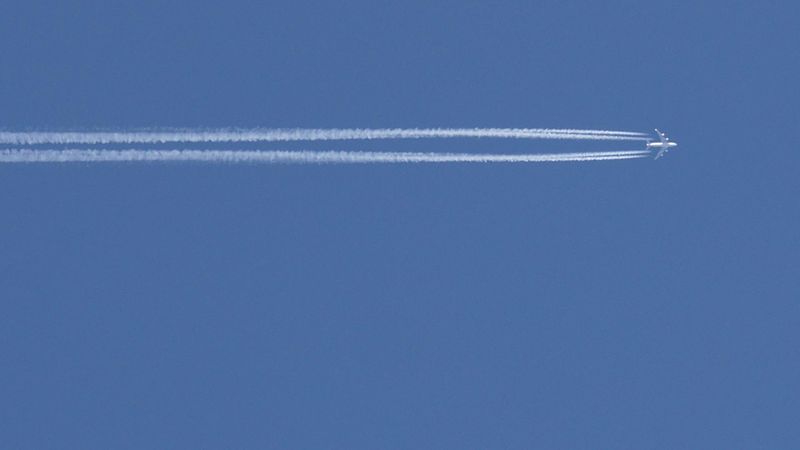Changing flight altitudes avoids the formation of climate-damaging contrails
An international research team has successfully demonstrated that long-lasting contrails can be avoided by adjusting flight altitudes.

Aircraft engines emit soot particles. These act as condensation nuclei for small supercooled water droplets, which immediately freeze into ice crystals and become visible as contrails in the sky. Credit: © DLR. All rights reserved
This article was first published on
www.dlr.deThe German Aerospace Center (Deutsches Zentrum für Luft- und Raumfahrt; DLR) and the EUROCONTROL Maastricht Upper Area Control Centre (MUAC) have jointly demonstrated that long-lasting contrails can be avoided by slightly changing flight altitudes. The procedure that was tested is an important step towards significantly reducing the climate impact of aviation in the long term. The results have now been published in the journal 'Meteorologische Zeitschrift' (in English).
In 2021, there was considerably less air traffic than in previous years due to the COVID-19 pandemic. A research team led by Robert Sausen from the DLR Institute of Atmospheric Physics and Rüdiger Ehrmanntraut from MUAC used this situation for analyses in the upper airspace over north-west Germany and the Benelux countries.
The 'avoidance' procedure was used every alternate day, when the weather forecast for the flight altitudes used by regular air traffic suggested that long-lasting contrails would form. The flights were diverted up or down by 2000 feet (approximately 660 metres). The researchers then used satellite images to check whether or not long-lasting contrails had formed. The flights on the days when air traffic was not subject to the procedure served as a reference. The research team was able to show that long-lasting contrails occurred less frequently.
Avoiding the climate impact of contrails
The overall climate impact of aviation is significantly greater than its carbon dioxide emissions alone. This is due to what are referred to as non-carbon-dioxide effects. These are comparatively large in the case of air transport. The reason for this is that aircraft usually emit at altitudes where their emissions have a different effect than on the ground and have a particularly large climate impact. The non-carbon-dioxide effects of air transport include, in particular, contrails and contrail cirrus – that is, ice clouds. The non-carbon-dioxide effects of aviation can have both a warming and a cooling effect, with the warming effect predominating. As they only have short atmospheric lifetimes compared to carbon dioxide, the effects are not evenly distributed in the atmosphere. Their effect on the climate therefore depends heavily on numerous parameters – geographical location, altitude, time of emission, position of the Sun and weather conditions. This opens up the possibility of reducing the climate impact of aviation by choosing suitable flight routes and altitudes (referred to as climate-optimised flight trajectories). However, the use of climate-optimised flight trajectories generally leads to increased carbon dioxide emissions. As such, the optimised flight trajectories must be selected in such a way that the overall climate impact of the flight in question is reduced.
Important prerequisites for the possible introduction of such climate-optimised flight trajectories include:
- The climate impact of individual flights must be able to be predicted so reliably by the weather services that a diversion of air traffic actually leads to a reduction in the climate impact.
- The climate impact of non-carbon-dioxide effects must be integrated into the operational tools and processes for planning flight trajectories. This requires a system that calculates the climate impact of a flight with sufficient accuracy within the time available for flight planning.
- When flights are rerouted in higher airspace, it must be ensured that authorised air traffic can continue to be handled safely, in an orderly way and without delays, because taking climate aspects into account when selecting trajectories can lead to capacity bottlenecks in the airspace.
In contrast to the other non-carbon-dioxide effects, in the case of long-lasting contrails it is possible to control whether more or fewer contrails are formed. This requires sophisticated statistical methods. The DLR and EUROCONTROL/MUAC team used this to prove that the avoidance of long-lasting contrails actually works in real air traffic. This is a successful step on the way to climate-friendly air transport.